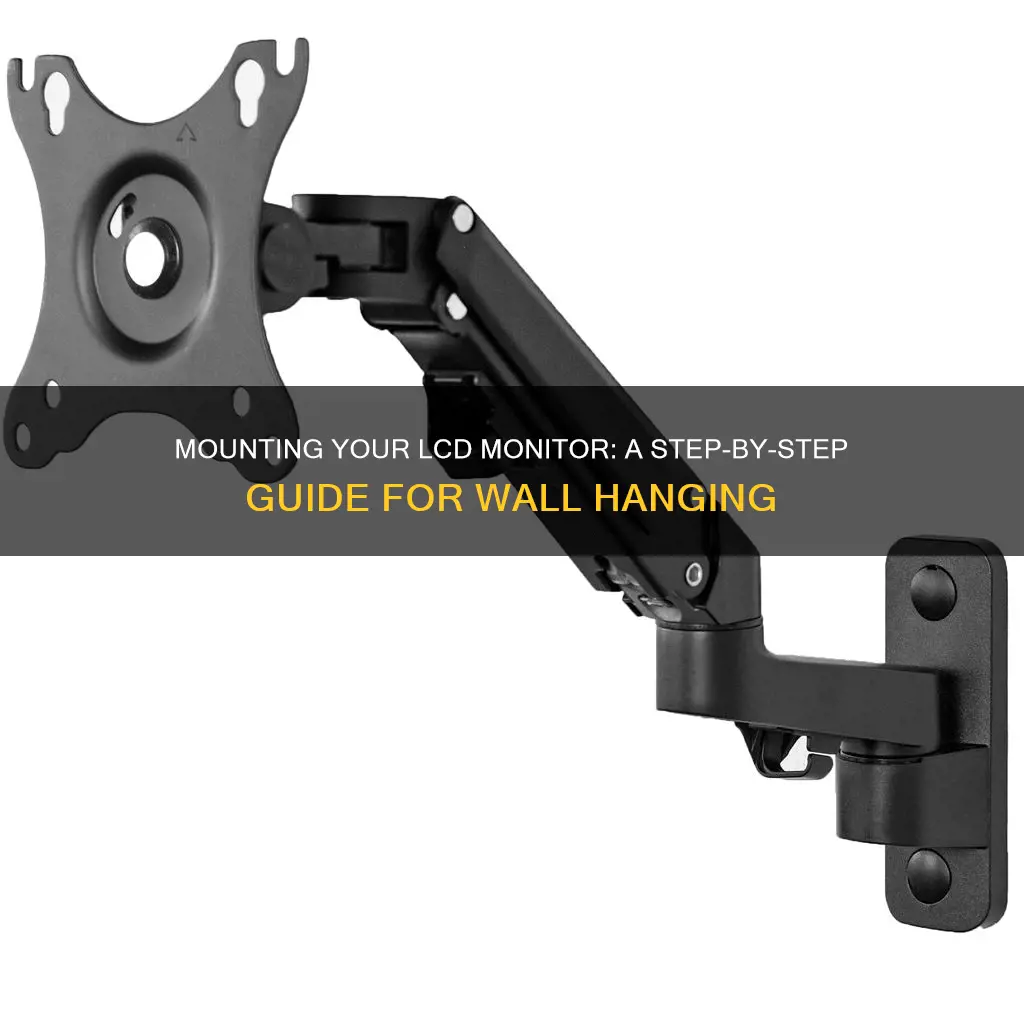
Hanging an LCD monitor on a wall can be a great way to save space, especially if you're working with multiple monitors. There are two basic types of mounts for monitors: non-invasive desk mounts and wall mounts. Desk mounts are often cheaper and quicker to install, but they take up desk space and require a sturdy desk. Wall mounts, on the other hand, are more involved to install and require additional tools and drilling into walls, but they save desk space and provide a sturdy mounting surface. In this article, we will focus on the process of hanging an LCD monitor on a wall using a wall mount. We will cover the tools and materials needed, as well as the step-by-step process to ensure a secure and safe installation.
| Characteristics | Values |
|---|---|
| Materials | 2 feet of 1/16th-inch uncoated cable, #10 x 2-inch wood screw, 1/8th-inch cable clamp, M4-0.70 x 16 mm machine screws, 1/8th-inch x 3/4th-inch diameter washers, dental floss, socks, weight (keys), drill, two pairs of pliers, marker, screwdriver, matching bit for wood screw, set of drill bits |
| Tools | Cordless drill, vice, marker, screwdriver, set of drill bits |
| Steps | Find a stud in the wall, place a support screw, assemble the harness, hang and position the monitor |
| Monitor Desk Mount Characteristics | Non-invasive, cheapest, quickest to install, takes up desk space, requires a sturdy desk |
| Monitor Wall Mount Characteristics | More invasive, requires additional tools, provides more desk space, sturdier, leaves traces in the wall, more expensive for multiple monitors |
What You'll Learn

Finding a stud
When hanging an LCD monitor on the wall, it is important to find a stud to ensure the fixture is sturdy. A stud is a piece of wood behind the drywall that will provide a strong mounting surface.
There are a few ways to find a stud. One way is to use an electronic stud finder, which will light up when it finds the centre of a stud and will also alert you to any nearby electrical wires. You can also try drilling into the wall to find a stud. Start by drilling straight into the wall with the smallest drill bit. If there is nothing behind the drywall, the drill will move forward with little resistance. If this happens, drill to either side of the first hole. Continue this pattern until you drill through the drywall and meet resistance. When you need to force the drill forward, chances are you've found a stud. You can check by gently removing the drill bit and looking for any signs of wood.
Once you've found a stud, you can try to find another one closer to where you want to place the monitor. To do this, measure a set distance to either side of the first drill hole. This distance is often 16 inches, but it can be 12 inches in older homes or 24 inches in modern homes.
After finding a stud, you can mark the centre with a pencil and use a level to draw a vertical line down the wall in the area where you wish to install the mount.
Troubleshooting an ASUS Monitor That Won't Detect HDMI
You may want to see also

Placing the support screw
Now that you've found a stud to support the weight of your monitor, it's time to mark the spot where you'll drill the pilot hole for the support screw. Take a piece of string and tie it to a weight. Dangle the weight over the hole where you found the stud and make a small mark on the wall where you'll drill the pilot hole. This will ensure that your monitor is centred and positioned as desired.
Next, select a drill bit that is smaller than the diameter of the shaft of the wood screw. For a #10 wood screw, a 7/64th inch bit is a good choice. Drill a hole on the mark at a downward angle. This angle is important as it ensures that the monitor will slide down and against the wall, reducing the risk of it falling.
Now, simply insert the wood screw into the pilot hole. With the support screw in place, you're one step closer to securely hanging your LCD monitor on the wall.
The next step is to assemble the harness, which will involve preparing the monitor and attaching washers, machine screws, and cables.
Attaching a Stand to Your ASUS 228H Monitor: A Guide
You may want to see also

Assembling the harness
Now it's time to assemble the harness that will hold your LCD monitor on the wall. First, remove the base from the monitor. Then, place a pair of washers and a machine screw in the top two mounting holes of the monitor. Leave them loose for now.
The next step involves the cable. Overlap the ends of the cable to make a loop. Size the loop by placing the bottom of it around the mounting, ensuring that the loop doesn't exceed the top of the monitor. This will make sure that the cable is hidden from view once the monitor is hung. Place a mark on both legs of the cable, making sure that the marks are far from either end and at a point where the cable overlaps.
Now, fold over both ends of the cable by about one and a half inches, ensuring that the mark is centred in each fold and that the size of the loop remains unchanged. These folds will increase the diameter of the cable, making it less likely to slip and more likely to be engaged by the clamp. Cut off any excess cable using a large pair of pliers.
Insert both ends of the cable into the clamp from either side, lining up the markings, and place the clamp on the markings. Hand-tighten the nuts, then use two pliers to tighten each nut as securely and evenly as possible. The tighter the clamp, the less likely the monitor is to fall and break.
Finally, place the bottom of the loop through the washers on each screw on the back of the monitor. Use a pair of pliers to tighten the screws, but be careful not to over-tighten them and strip out the threading.
Monitoring Internet Usage: Boost Mobile's Data Insights
You may want to see also

Hanging and positioning the monitor
Now that you have prepared the wall and the monitor, it's time to hang and position the monitor.
First, remove the base from the monitor. Then, place washers and a machine screw in the top two mounting holes of the monitor. Leave them loose for now.
Next, you will create a loop with the cable. Overlap the ends of the cable and size the loop by placing the bottom of it around the mounting, ensuring that the cable will be hidden from view when the monitor is hung. Mark both legs of the cable and fold over both ends by about 1.5 inches, keeping the loop the same size. Cut off any excess cable. Insert both ends of the cable into the clamp and tighten the nuts with pliers.
Place the bottom of the loop through the washers and screws on the back of the monitor and tighten the screws carefully.
Now, place the top of the loop over the support screw and slowly remove your support from the monitor. With a hand under the monitor, push down slightly to ensure that the screw can support the weight.
Finally, fold a pair of socks and place them at the lower corners of the monitor. Orient the monitor as desired, and plug in the cables.
If you are using your monitor as an extension of your desktop in Windows, navigate to the desktop, right-click, and go to Properties, then the Settings tab. Here, you can extend the desktop to the second monitor and orient it relative to your primary monitor.
Monitoring Water Usage in Hillsborough, California: A Guide
You may want to see also

Using a monitor wall mount
Step 1: Choose the Right Wall
Select a sturdy wall that can support the weight of your monitor. Ensure there is a wall stud to provide a strong mounting surface. Use a stud finder to locate the stud and mark its position.
Step 2: Prepare the Monitor
Check if your monitor is VESA compatible. Most modern monitors have mounting holes drilled into the back, usually in the steel frame. If your monitor doesn't have these holes, you may need to purchase an adapter or build your own mount. Remove the existing stand from your monitor, if necessary.
Step 3: Assemble the Wall Mount
Follow the instructions provided with your VESA mount to attach it to the wall. Ensure the mount is level and securely fastened. Some mounts may include a cardboard pattern to help you mark the holes for drilling.
Step 4: Attach the Monitor to the Mount
Place the mounting bracket over the holes on the back of the monitor, aligning the holes and grooves. Secure the bracket to the monitor with the provided screws. Carefully lift the monitor and align the bracket with the mount on the wall.
Step 5: Finalize the Installation
Attach the bracket to the mount, following the instructions provided with your mounting kit. Connect any necessary cables, such as power and video cables, ensuring they are neatly tucked away. Adjust the monitor's angle and height to your preferred position.
Additional Tips:
- Always refer to the user manual for specific instructions and requirements for your monitor and mounting kit.
- Be cautious when drilling into walls, especially if there are electrical wires nearby.
- Consider the weight limits of your mount and ensure your monitor doesn't exceed them.
- Adjust your monitor's height and distance for optimal ergonomics.
By following these steps, you can safely and securely mount your monitor on the wall, creating a functional and aesthetically pleasing setup.
Understanding Aspect Control and Overscan on ASUS Monitors
You may want to see also
Frequently asked questions
There are two basic types of mounts for monitors: non-invasive desk mounts that clamp onto your desk, and wall mounts that require drilling holes into your wall.
Desk mounts are often cheaper and quicker to install, and they don't require any drilling. However, they take up desk space and require a sturdy desk to handle the weight of the monitor(s).
Wall mounts provide more desktop space and a sturdy mounting surface using a wall stud. They are also less expensive for triple-monitor and higher configurations compared to desk mounts.
You will need a stud finder, a level, a cordless drill, drill bits, and a pencil. For the mounting hardware, you will need screws, washers, bolts, and a mounting bracket.
First, find a stud behind the drywall using a stud finder. Mark the center of the stud and use a level to draw a vertical line. Mark and drill the holes, screw in the mount, and attach the VESA mounts to the back of the monitor. Finally, slip the monitor onto the plate and secure it with screws or bolts.







